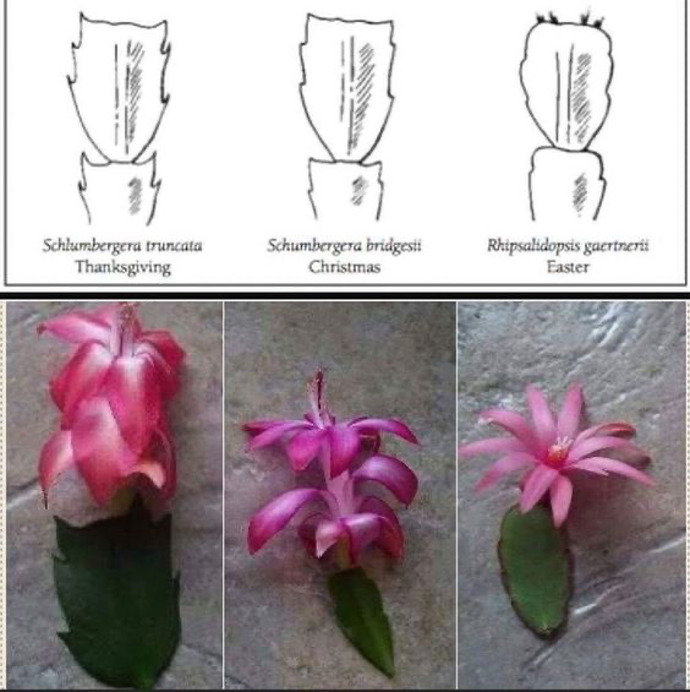Master Gardener: What do I have? A Thanksgiving, Christmas or Easter Cactus?
Published 12:28 am Sunday, December 13, 2020
|
Getting your Trinity Audio player ready...
|
By Sheri Bethard
Master Gardener
Holiday cactuses are not the spiny plants that we have in our cactus garden. These cactus plants are epiphytes that originate from the tropical treetops of the rainforests and natural forests of Brazil. These cactuses produce beautiful blooms that vary in color from bright orange, red, and purple to more subtle pink and white colorations. There are three varieties of holiday cactus; the Thanksgiving cactus (Schlumbergera truncata), the Christmas cactus (Schlumbergera bridgesii), and the Easter cactus (Rhipsalidopsis gaetneri). These three plants all look alike, and they require similar care, but there are differences that you should note. Let’s take a more in depth look at each variety.
The Differences between Thanksgiving Cactus, Christmas Cactus and Easter Cactus
Even though holiday cactus plants tend to look similar, look more closely at the leaves. This is the best way to tell the three plants apart other than the time of year that they bloom. If the plant has broad, thin leaves that have three points on each side, you are looking at a Thanksgiving cactus. Christmas cactuses have segmented leaves that are more round with small indentations, and Easter cactus plants have small bristles on the edges of their leaves.
The Thanksgiving Cactus (Schlumbergera Ttruncata)
The leaves of Thanksgiving cactus plants are broad and flat with small serrated edges. These plants often bloom in shades of pink, yellow, white, or red, which adds a bright contrast to your traditional fall décor. The blooms of this plant typically last two to four months, but in order for them to bloom again the following year, you need to trick the plant into entering a dormant stage by providing it with less light and colder temperatures.
These plants should be pruned during the summer months, and prepared for their Thanksgiving blooming period in September. During this time, the plant needs 12 hours of darkness a day.
The Christmas Cactus (Schlumbergera Bridgesii)
Christmas cactus plants are very similar to Thanksgiving cactus; in fact, they are often mistaken for them, but there are differences that appear mainly with the stems, leaves, and the blooming period. This variation of holiday cactus has very flat stems and broad leaves that have rounded indentations. They are still segmented leaves, but they actually look quite different when you look at the foliage.
Since this is a Christmas cactus, it is meant to bloom near the Christmas holiday. To make sure that this occurs, you may need to force the plant into a dormant state This means that the plant will need at least 12 hours of darkness each day, less water, and temperatures of about 55 degrees Fahrenheit. This dormant period should begin in October and last for about four to five weeks. When this is done correctly, you will have beautiful blooms for Christmas that will last for a period of eight weeks.
The Easter Cactus (Rhipsalidopsis Gaetneri)
This is another type of holiday cactus that is similar to the Christmas and the Thanksgiving variety, but the main difference between these plants is that the Easter cactus blooms in the spring of the year. They typically begin budding in March, and blooms can be enjoyed during April and May. The leaves also vary a bit from the other two plants that we have discussed. These leaves are still segmented and broad, but they have small bristles at the ends of the foliage that help distinguish them. In addition, the flowers themselves are a bit more star-shaped than the others.
The blooms that form on Easter cactus plants are often a bit brighter in coloration, so you can expect to see bright pinks, reds, and royal purple petals, which are perfect for adding a festive aspect to your dining area for Easter dinner. There are a few variations that produce white blooms, but they are less common than the bright vivid blooms.
The trick to getting your Easter cactus to produce beautiful blooms is to grow the plant outdoors from June until August. Make sure it is located in a shady place, and when fall arrives, bring the plant indoors to get rest during the cold months of the year. Buds should start to appear in late February or early March. Limit direct sunlight and water during the resting period, and try to keep the temperature between 45 degrees Fahrenheit and 59 degrees Fahrenheit.
Helpful Tips
- All Holiday cactus needs to be forced to bloom, which occurs about two months before the blooming period. This requires a few weeks of shorter days, less water, and longer periods of uninterrupted darkness.
- Never overwater these plants because these tropical plants are sensitive to excess water on their roots, especially the Easter cactus.
- High temperatures, excessive heat fluctuation, and dry air is not ideal for a holiday cactus, so if your home is excessively dry because of a wood stove or another form of dry heat, make sure to mist the leaves to create humidity around the plants.
Now that you can differentiate between a Thanksgiving cactus, a Christmas cactus, and an Easter cactus, make sure that you have the plant that you think you are growing. They are all easy to care for and maintain, so you can easily have a few of each if you want.
Adapted from: https://tinyurl.com/y2l6v58f







